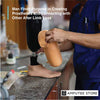Health Insurance 101: The Difference Between Copay and Coinsurance
Choosing a health plan can be challenging enough on its own, considering that you need to project as accurately as possible how much healthcare you’ll be needing the following year. Add to that other health insurance-related financial responsibilities such as copay and coinsurance, and choosing a plan may not be as straightforward as it should be.

In this article, we will help you wade through the confusion that health insurance lingo might induce, so you will be able to choose the right plan for your needs and, of course, your wallet.
The cost of health insurance
While health insurance is not cheap, it protects you from the rising costs of healthcare, which saves you money in the long-run.
One of the first financial responsibilities that come with health insurance is the premium, which can be paid monthly, quarterly, or annually, depending on your arrangement with your health insurance provider.
But apart from premiums, health insurance entails additional costs that you need to take into account when deciding which plan to get: copay and coinsurance. While both terms may seem the same, one works quite differently from the other.
Copay
Copay requires you to pay a fixed amount for certain services. For example, seeing your primary care doctor might cost you $25 in copay, but seeing a specialist—like your prosthetist—may require paying a higher cost that is predetermined by your insurer.
Coinsurance
Meanwhile, coinsurance requires you to pay a predetermined, fixed percentage of the total cost of every medical service you receive. For example, you may be obliged to pay 20% of the total bill of your physical therapy, while the health insurance company covers the remaining percentage.
Understanding how copay and coinsurance work
Your health insurer predetermines your copay and coinsurance. This is largely dependent on the type of health plan you choose. However, keep in mind that there are instances when you will be billed for the full amount.
Another perk of getting health insurance is the annual general checkups. Some plans cover 100% of your yearly checkup, which means you only need to pay the predetermined copay. Meanwhile, other plans will only cover a specific amount of the general checkup (for example, $100). This type of arrangement will then require you to pay the remaining amount of the checkup plus the copay.
Before scheduling an appointment, always double-check with your insurance company, so you are sure what services or percentages are covered by your plan. You can also call the clinic or hospital to ask about the expected costs.
Out-of-pocket maximum
Another term that you need to be familiar with is “out-of-pocket maximum,” which refers to the maximum amount you’ll need to pay. Simply put, out-of-pocket payments cover copay, coinsurance, and deductibles—money that you need to pay for your healthcare out of your pocket. But keep in mind that out-of-pocket expenses do not include your insurance premiums.
Once you’ve spent the predetermined maximum amount, your health insurer should take on 100% of any additional costs.
When it comes to health insurance, being fully aware of coverage is key. So, if an employer insures you, you need to talk to human resources to clarify your financial responsibilities. Health insurance significantly lightens the financial burden if you do need medical attention. It’s best to get the financial facts straight before that happens to avoid future stress.










































































